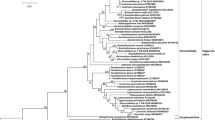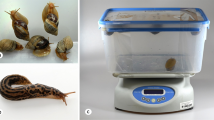Abstract
Both adults and juveniles of the oribatid mite Scutovertex minutus (Scutoverticidae) may enter an immobile quiescent state under extreme dry conditions. The microanatomy of the alimentary tract, contents of parenchyma tissue and internal extraintestinal microbial communities were observed in these states. The quiescent state lasted at least 10 days and was generally characterized by an empty gut, guanine deposition and, in adults, by the resorption of spermatids or oocytes and eggs. The homogenate of mites was sterile, without microorganisms. The reverse processes were recorded two hours after re-moistening: the mites started to move again and accompanying histological changes were shown.
Similar content being viewed by others
References
Alberti G. and Coons L.B. 1999. Acari: Mites. In: Harrison F.W. and Foelix R.F. (eds), Microscopic Anatomy of Invertebrates. Vol. 8C. Chelicerate Arthropoda. Wiley & Sons, Inc., Chichester, pp. 515-1215.
Block W. 1980. Survival strategies in poler terrestrial arthropods. Biol. J. Linn. Soc. 14: 29-38.
Evans G.O. 1992. Principles of Acarology. CAB International, Wallingford, 563 pp.
Grandjean F. 1953. Essai de classification des Oribates (Acariens). Bull. Soc. Zool. France 78: 421-446.
Krantz G.W. 1978. A manual of acarology. 2nd edn. Oregon State Univ. Book Stores, Inc., Corvallis, Oregon, 509 pp.
Madge D.S. 1961. The behaviour of free living mites as affected by humidity. Anim. Behav. 9: 108.
Madge D.S. 1964a. The water relation of Belba geniculosa and other species of oribatid mites. Acarologia 6: 199-223.
Madge D.S. 1964b. The humidity reactions of oribatid mites. Acarologia 6: 566-594.
Smrź J. 1989. Internal anatomy of Hypochthonius rufulus (Acari: Oribatida). J. Morphol. 200: 215-230.
Smrź J. 1992a. Some adaptive features in the microanatomy of moss-dwelling oribatid mites (Acari: Oribatida) with respect to their ontogenetical development. Pedobiologia 36: 306-320.
Smrź J. 1992b. The ecology of the microarthropod community inhabiting the moss cover of roofs. Pedobiologia 36: 331-340.
Smrź J. 1994. Survival of Scutovertex minutus (Koch) (Acari:Oribatida) under differing humidity conditions. Pedobiologia 38: 448-454.
Smrź J. 1995. Free cells in the body cavity of oribatid mites (Acari: Oribatida). Pedobiologia 39: 488-495.
Smrź J. 1996. Some aspects of the life strategy of oribatid mites (Oribatida). In: Mitchell R., Horn D.J., Needham G.R. and Welbourn W.C. (eds), Acarology IX: Volume 1, Proceedings. Ohio Biological. Survey, Columbus, Ohio, pp. 553-555.
Smrź J. 1998. Interactions between oribatids and micro-organisms: A complex method of study. Appl. Soil. Ecol. 9: 109-110.
Smrź J. 2000. A modified test for chitinase an cellulase activity in soil mites. Pedobiologia 44: 186-189.
Smrź J., Svobodová J. and Catská V. 1991. Synergetic participation of Tyrophagus putrescentiae (Schrank) (Acari: Acaridida) and its associated bacteria on the destruction of some soil micromycetes. J. Appl. Entomol. 11: 206-210.
Smrź J. and Trelová M. 1995. The associations of bacteria an some soil mites (Acari: Oribatida and Acaridida). Acta. Zool. Fenn. 196: 120-123.
Vannier G. 1978. La résistance a la desication chez les premiers arthropodes terrestres. Bull. Soc. Ecophysiol. 3: 13-42.
Volgin V.I. 1973. The hypopus and its main types. In: Daniel M. and Rosick B. (eds), Proceedings of the 3rd International Congress of Acarology. Academia Publ., Prague, pp. 381-383.
Woodring J.P. and Carter S.C. 1974. Internal morphology of the deutonymph of Caloglyphus boharti (Arachnida: Acari). J. Morphol. 144: 275-295.
Woodring J.P. and Cook E.F. 1962. The internal anatomy, reproductive physiology, and molting process of Ceratozetes cisalpinus (Acarina: Oribatei). Ann. Entomol. Soc. Am. 55: 164-181.
Author information
Authors and Affiliations
Rights and permissions
About this article
Cite this article
SmrŽ, J. Microanatomical and microbiological characteristics of the quiescent state of Scutovertex minutus (Acari: Oribatida). Exp Appl Acarol 27, 103–112 (2002). https://doi.org/10.1023/A:1021527904766
Issue Date:
DOI: https://doi.org/10.1023/A:1021527904766




